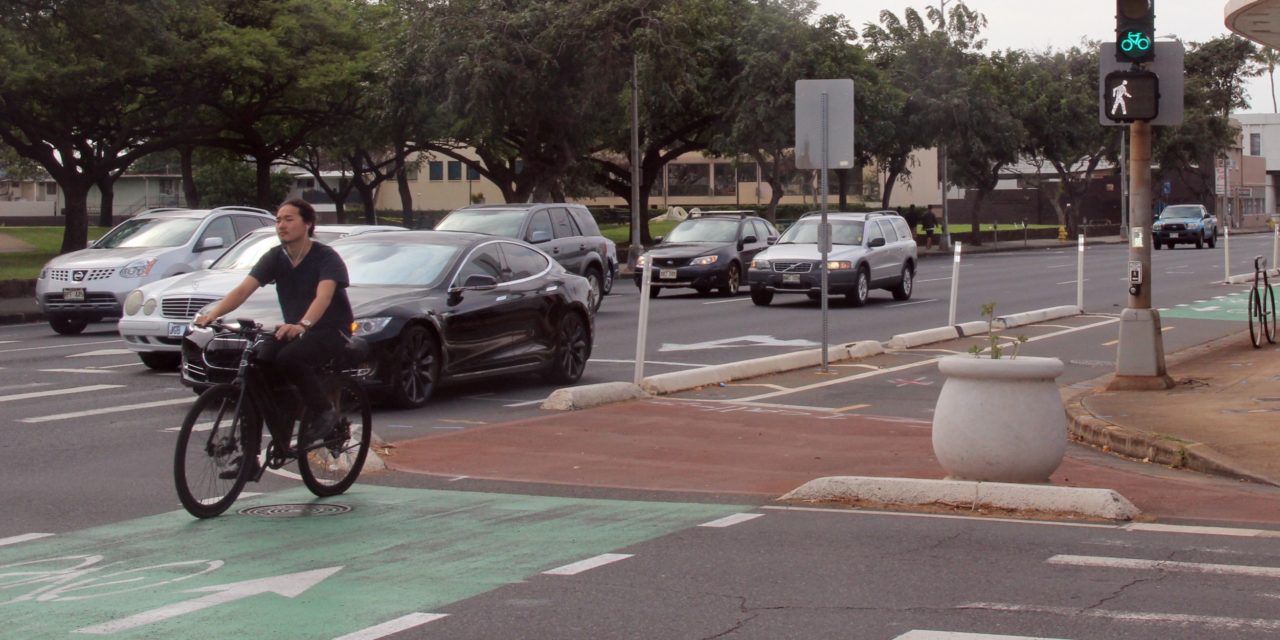By Chris Takahashi | Staff Writer
I recently bought a bicycle to explore Honolulu at a more leisurely pace. The exercise aspect and environmental benefits of bicycling were factors that compelled me to make the purchase, in addition to the dreamy idea of being able to bike to the beach with my surfboard in tow.
After taking a one-way trip to Kalihi Valley, I was able to pick up a used bike from the Kalihi Valley Instructional Bike Exchange (KVIBE), which is an awesome nonprofit that refurbishes used and donated bicycles. For my first ever spin around town on a bike, the roughly 6-mile journey back home seemed like a fairly serious commitment, primarily due to the lack of protected bicycle lanes in Honolulu.
Passing by Queen’s Hospital, I hopped on the sidewalk since there was no safe bicycling lane in sight. I did not want to take my chances with cars zooming by, and sure, my helmet would cushion a slight blow to the head, but I wouldn’t trust it beyond that. Not more than 30 seconds on the sidewalk and the scolding began by a lady walking her dog. “You can’t bike on the sidewalk!” she yelled in a cranky voice as I passed by. To my defense, I was moving very slowly and gave a wide berth, but that didn’t matter. Further, I was not going to start an argument with her since bicycles are prohibited from sidewalks in downtown business areas and Waikiki.
Honolulu is making strides toward greater integration of protected bicycling lanes on major thoroughfares across the city. These efforts are commendable and should be expedited. But the core issue for Honolulu, specifically due to the high volume of traffic, is simply the limited infrastructure of protected bicycling lanes. Without protected lanes, bicycling in Honolulu is a risky endeavor with little mass appeal. Ideally, Honolulu must move quickly to encourage bicycle ridership with the construction of more protected bicycle lanes.
As of August 2016, Oʻahu has 2 miles of protected bike lanes, 46 miles of bike paths, 59 miles of bike lanes, and 40 miles of bike routes, according to the website for the City and County of Honolulu.
The 2-mile protected bicycling lane on King Street, the first and only in the city, officially opened in December 2014 as a one-way lane and became a two-way lane in May 2015, according to the Hawai‘i Bicycling League. Plans for additional protected bicycling lanes across the state can be found within the Department of Transportation Services (DTS) Oʻahu Bike Plan, published in August 2012.
The draft map embedded in the plan shows highlighted routes that are under consideration for protected lanes. The 105-page report provides a complete picture for a bicycle-friendly system across the island. The report includes plans for ensuring adequate bicycle parking as well as plans to link existing public transportation, such as the bus, with protected bicycling routes throughout.
According to Austin Rose, a civil engineer for the City and County of Honolulu, construction is projected to begin for a protected bicycling lane on South Street near downtown Honolulu in March. The DTS plan priorities a number of routes to be completed in the next 5 to 10 years. Streets that may be included in this timeline, according to the draft map, include Pi‘ikoi Street and Kalākaua Avenue.
Survey data for the years 2008-2012 from the U.S. Census Bureau showed that Honolulu ranked 15th per capita for commutes by bicycle on the list of urban cities with populations greater than 200,000. Likewise, per-capita rates of walking to work placed Honolulu at No. 8 on the list for the same time period.
With a more comprehensive network of protected bicycling lanes, surely more people would opt for bicycling over walking during their morning and evening work commutes. Further, Honolulu benefits from a sunny and relatively dry climate and, coupled with (mostly) flat streets, is an ideal city for a network of protected bicycling lanes.
I’ve experienced the bicycling culture in Montreal, Canada, and the city ranks high on lists of bicycle-friendly cities in North America. The bike share program of Montreal, called BIXI, benefits from nearly 400 miles of bicycle lanes. More than a third of those lanes are protected, according to an article from the Guardian in June 2015.
Bicycling in Montreal using the BIXI bike share program was an absolute blast and ridership in the city is high. There is a constant flow of people riding bicycles throughout the city (at least in the summer months) and you can even ride across the Saint Lawrence River to visit Notre Dame Island. As a tourist, it was a great way to explore the city as you can see everything from practically the same viewpoint as a pedestrian. With the hop-on and hop-off nature of the bike share program, it was easy to fit in many sights.
One strong selling point for a bike share program in Honolulu (there’s one in the works; see www.bikesharehawaii.org for more information) is the fact that it’s not just a cliche to say that there’s safety in numbers. A 2013 report from the Organisation for Economic Co-operation and Development (OECD) proves conclusively that a higher volume of bicycle riders will lead to a lower accident rate per bicycle kilometers traveled. The bicycle accident fatality rate for the United States is about four times higher than that of the Netherlands, a country with a robust bicycling culture, according to the OECD report.
While Honolulu’s master plan for protected bicycling lanes will take money and time to complete, there is a piece of legislation that will help promote a safer bicycling culture in the meantime. House Bill (HB) 191 concerns the amount of space that cars must afford to bicyclists while overtaking them from the left-hand side. The minimum amount of space proposed in the bill is 3 feet.
According to data from the National Conference of State Legislatures (NCSL), at least 39 states — including Washington, D.C. — have legislation that designate a safe amount of space required for cars passing bicyclists on the road. HB 191 recently passed out of the Transportation Committee in the House of Representatives on Feb. 10.
Passing this legislation is an important step in ensuring that Hawai‘i cultivates a bicycle-friendly culture. This bill, if passed, will complement Honolulu’s current plans to roll out both more protected, and unprotected, bicycling lanes throughout the city.
As an island state, we must take seriously our responsibility in promoting a more sustainable society. Protected bicycling lanes will not be the panacea alone, but they certainly signify progress on the sustainability front. With a comprehensive network of protected bicycling lanes, Hawai‘i can lessen its dependence on imported fossil fuels and pave the way for a more dynamic and safe system of accessible transportation.
Plus, for short rides around town, bicycling is much more fun than hopping in the car. And, the best part: no gas money required.







While I support cyclists and the concept of a city that is bike friendly, as a driver I’m frustrated at the added challenges on the road, especially in an atmosphere where both pedestrians and cyclists feel they need to challenge their right-of-way, often not even caring to look around at the drivers before crossing intersections and driveways.
But very interesting piece.